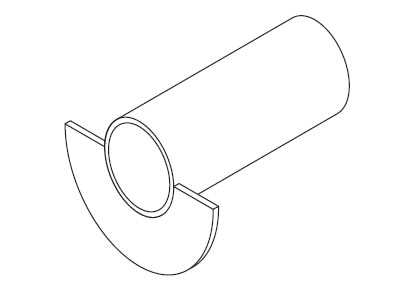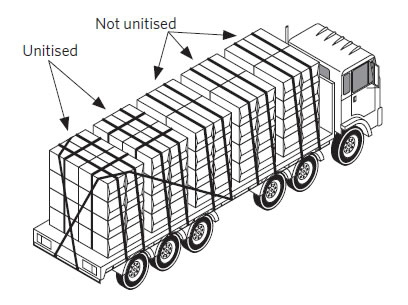The floor of the truck or trailer should be in good condition and for long-haul deliveries protective sheeting should be laid down prior to loading.
Where reels sit on raised coamings, levelling dunnage at least 100mm wide and of coaming height should be used alongside the coamings. Two strips should be placed adjacent to the longitudinal centre line of the loading space.
All long-distance transport of finished product should be effectively weather protected.
Chains, ropes, corner boards and chocks must be effectively refitted after delivering part loads. Core plugs, where used, should be replaced in reels as each reel is delivered.
It should be noted that in addition to the flat deck trucks and semi-trailers considered in this code, it is possible to transport reels and palletised or unitised products in van-type semi-trailers, provided forward, rearward and lateral restraints are provided within the confines of the van.
Each set should comprise equipment which meets the requirements outlined in Load-securing equipment.
Chains are used to fulfil two main functions:
The tendency of chains (as primary restraints) to lose tension is related directly to movement of links that are in contact with the core protectors and the tie rails and coaming. Short links tend to move less and are preferred to long links.
Turnbuckles, where required, should be of the standard specified about chains.
Core protectors, when required, should be flanged in a manner to protect the core and reel ends (see figure 74).
All edges and parts of the core protectors that may come into contact with rope should be radiused and ground smooth.
Wooden chocks of at least 100mm wide and 150mm high should be provided. Ropes are threaded through holes in the chocks in sets of two or four to assist in securing them to the side rails and also to reduce the risk of falling from the truck and causing a hazard to following traffic.
Chocks must not be left loose on the truck floor while the truck is in motion, because of the danger to following traffic.
Where cores are plugged, corner boards should be used to restrain sideways movement of top reels. Boards should be 150mm × 40mm timber and about 2400mm in length. When used, the restraining lashings must have a combined rated strength at least equal to the weight of the load.
For general assistance in manoeuvring of reels, only round pipe or bars whose outside diameter is no less than 32mm are acceptable. One end should be flattened and any sharp edges ground off. Bars must not be left loose on the truck floors when the truck is in motion, because of the danger to following traffic. A duralumin bar or other alloy bar of adequate strength is acceptable.
Enough ropes to meet all requirements for securing the load are required. Each rope should be not less than 9 metres long. For some applications longer ropes may be required.
Specification of rope - load-securing equipment
 Figure 74 Core protector
Figure 74 Core protectorReels up to 1000mm diameter – should preferably be secured in unitised modules. However, where stowed loose, the securing principle applicable to larger reels should be observed.
Reels 1000mm to 1300mm diameter (including fully wrapped reels) – reels in this diameter range may be stowed one and two high on the barrel. Two large wooden chocks should be placed symmetrically behind each rear reel or reels and in front of each front reel except where permanent front chocks are provided. Secure all main chocks tightly by threading rope through the holes in the chocks and tying to the tie rails. After inserting core protectors in the outer facing ends of the front and rear bottom reels, place chains through the cores of the rear and front bottom reels and tighten with turnbuckles diagonally to the side rails. Take care to keep them clear of reel ends during tightening. The chains should be angled at less than 45° to the horizontal.
Reels up to 500kg – fit core protectors to each reel in the top row and apply 12mm polypropylene ropes.

Figure 75 Loading requirements for barrel stowed rolls 1,000mm diameter and overkl
Reels 500kg to 1000kg – fit core protectors and either apply chains to the top row, or ropes to each reel in both the top and bottom rows.
Reels 1000kg or more – fit core protectors to all reels in the top row and apply chains to each of these reels.
Remember the combined rated strength of chains and ropes used must equal at least the total weight of the load.
Reels 1500mm to 1730mm diameter – the same securing methods applicable to 1000mm to 1300mm diameter reels apply but the reels should not be stowed two high.
Narrow width reels – reels whose width is less than half the diameter should not be barrel stowed more than one high. Otherwise use the same securing methods applicable to the corresponding diameter but wider reels.
Subject to the characteristics and the bale formation, it may be necessary to restrict the loading to less than four high. Figure 76 illustrates this.
Each lateral row of bales, whether palletised or not, should be secured with one cross rope from side to side, and the rear of the load secured by a pair of ropes crossed diagonally from the rear and then over the load well forward to the side tie rails. Pulp must not overhang the rear of the vehicle.
The diagonal pair of ropes may be omitted when the vehicle is fitted with a rear load rack in position, provided the rear stack of pulp is located close to the rack and does not exceed the rack in height.
 Figure 76 Baled pulps
Figure 76 Baled pulpsSecure each unit with cross ropes from side to side with one rope per lateral row of bales. The rear of the load should be secured by a pair of ropes crossed diagonally from the rear, then over the load well forward to the side tie rails. Pulp must not hang over the rear of the vehicle. Refer to figure 76.
The diagonal pair of ropes may be omitted with unitised pulps when the vehicle is fitted with a rear load rack in position, provided the rear unit pulp is located close to the rack. Unitised pulp may exceed the rack in height.